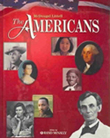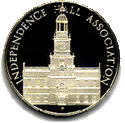American History Iby Matthew Caggia
- Unit 1A: Colonization & the 13 Colonies
- Unit 1B: Coming of the Revolution
- Unit 2A: Confederation & Compromise
- Unit 2B: The New Nation
- Unit 3: Sectionalism & Nationalism
- Unit 4: Reshaping the Nation
- Unit 5: Coming of the Civil War
- Unit 6: The Civil War
- Unit 7: Reconstruction
- Textbook
Unit 6: The Civil War
Chapters 11
It is finally here, the inevitable, the war for the nation. Will the United States live up to the promise of the Constitution? The question over state's rights will finally be settled, either the United States will be united under a single central government, or the states will dominate the continue to drive the direction of the nation. The greatest impact will be on slavery.
In this unit we will focus on the causes and battles of the Civil War and the impact it has on people and everyday lives. Especaially the lives of slaves, or former slaves.
Study Tools
Slideshows
The slideshows are best if viewed full screen.
Strengths and Weaknesses (of the North and South)
Use these Guided Notes while watching the following presentations.
Section 11.1: The Civil War Begins
Section 11.4: The North Takes Charge
Section 11.2: The Politics of War
Sections 11.3&5: Life During Wartime & The Legacy of the War
Online Textbook Resources
 |
"The Americans" TextbookThese pages contain the links to the online content for student practice. It includes Chapter Overviews, Web Activities, Self-Check Quizzes, ePuzzles and Games, Vocabulary Flashcards, Charts in Motion (to accompany diagrams in the textbook), and Interactive Graphic Organizers.
|
|
USHistory.org Free Online TextbookEach link is to the beginning of a chapter. There are several sections within each chapter; I would like to link to each section, however it becomes too cumbersome for the webpage. Instead, click "Next" on each page to get to the next section of the online textbook. |  |
|
Vocabulary
With only 4 Vocabulary terms for this unit (that's right ONLY FOUR!) there is not Quizlet page!
Videos!
America: The Story of Us - The Civil War
From the History Channel video, this segment documents the Civil War in the context of part of the American Identity. It demonstrates new technologies of war and their catastrophic effects. It will also chronicle some of the important events, such as Lincoln's "Gettysburg Address" and Sherman's March. Use the Video Guide as you watch to get the main points of each segment. Complete each topic as well as the crossword puzzle on the second page.
The Presidents: Abraham Lincoln
Watch the video and answer these multiple choice questions.
Crash Course American History #19: Battles of the Civil War
Warning: Not much content here, pretty much just a list of some of the battles of the Civil War.
Crash Course American History #20: The Civil War, part 1
From the Publisher
In which John Green ACTUALLY teaches about the Civil War. In part one of our two part look at the US Civil War, John looks into the causes of the war, and the motivations of the individuals who went to war. The overarching causes and the individual motivations were not always the same, you see. John also looks into why the North won, and whether that outcome was inevitable. The North's industrial and population advantages are examined, as are the problems of the Confederacy, including its need to build a nation at the same time it was fighting a war. As usual, John doesn't get much into the actual battle by battle breakdown. He does talk a little about the overarching strategy that won the war, and Grant's plan to just overwhelm the South with numbers. Grant took a lot of losses in the latter days of the war, but in the end, it did lead to the surrender of the South.
Crash Course American History #21: The Civil War, part 2
From the Publisher
In which John Green teaches you how the Civil War played a large part in making the United States the country that it is today. He covers some of the key ways in which Abraham Lincoln influenced the outcome of the war, and how the lack of foreign intervention also helped the Union win the war. John also covers the technology that made the Civil War different than previous wars. New weapons helped to influence the outcomes of battles, but photography influenced how the public at large perceived the war. In addition, John gets into the long term effects of the war, including the federalization and unification of the United States. All this plus homesteading, land grant universities, railroads, federal currency, and taxes.
Check out the US National Archives Flickr. They have an awesome collection of Matthew Brady Civil War photography here.
Links
- The Civil War Trust
A fantastic website dedicated to the Civil War and the preservation of Civil War battlefields, parks, and monuments. It includes a wealth of information about individual battles and the people involved. Interactive maps are an amazing component of this site, but it also includes diagrams, videos, and historic maps.
From the website:
The Civil War Trust is America's largest non-profit organization (501-C3) devoted to the preservation of our nation's endangered Civil War battlefields. The Trust also promotes educational programs and heritage tourism initiatives to inform the public of the war's history and the fundamental conflicts that sparked it.